The History Of Mitsubishi Minica

The Mitsubishi Minica is a kei car produced by Mitsubishi Motors for the Japanese domestic market since October 1962. It was first built by Shin Mitsubishi Heavy-Industries, one of Mitsubishi Heavy Industries' three regional automotive companies until they were merged in 1964. It is the oldest Mitsubishi passenger car still in production, and the only one which predates the company itself.
The precursor of the Minica was the Mitsubishi 360, a series of vans and Kei trucks introduced in 1961. Designed for the lowest kei car vehicle tax classification, it was powered by a 356cc engine producing 17PS (17hp/ 13kW). After the successful introduction of the Minica, the 360 continued alongside until 1966.
The first Minica was first introduced as a two-door sedan based on the Mitsubishi 360, with a front-mounted ME21 359cc twin cylinder two stroke air-cooled engine driving the rear wheels, transverse leaf springs in front and beam axle/ leaf springs at the rear.
In 1966, the Mitsubishi Minicab cab-over pickup truck was launched to replace the Mitsubishi 360. Powered by the same air cooled two-stroke 359cc engine as the Minica, it came with cargo gates on three sides to simplify loading and unloading.
The second generation Minica was introduced in July 1969 with a three-door sedan body, 359cc OHV engine and coil springs front and rear. Two 2G21 SOHC water-cooled powerplants were optionally available, the Red 28hp (21kW) engine and the Gold engine fitted with twin SU carburetors developing 38hp (28kW), which was fitted as standard to the GSS sport model. A two-door wagon body was added in December, which would remain in production until the fourth generation in the early 1980s.
The Minica Skipper was introduced in May 1971 as a two-door coupé with liftable rear window, and a choice of 2G21 Red or Gold engine.
Also in 1971 the Minicab underwent its first model change. The Minicab EL offered a new interior and a longer cargo bed. Ride quality was improved with the adoption of a front wishbone and rear leaf spring suspension.
The third generation Minica was introduced as the Minica F4 in October 1972 with a 359cc OHC engine in the same basic configuration, but with the liftable rear window of the coupé, which itself continued production with the new engine as the Minica Skipper IV. Also in 1972, a panel van was added to the Minicab lineup, along with the Minicab W with a new engine.
In April 1976 the kei car regulations were revised again, and the car and wagon received a new 471cc engine, a small increase in length, and a new name, the Minica 5. The next year, the car and engine grew once again, creating the Minica Ami 55.
In 1977, the third generation Minicab was introduced. In keeping with the changes in vehicle tax regulations, the Minicab Wide 55 featured an increase in both width and length, and adopted the enlarged engine from the car line. It also incorporated new features like a windscreen defroster, a central console box and a central ventilation system.
In 1981 the car received a facelift which again increased its size, and it was renamed Minica Ami L, while the wagon was replaced with the Minica Econo three-door sedan. Mitsubishi dropped Wide 55 from the Minicab name as the market was now aware of the increase in body size and engine capacity. A rear window wiper, electronic locking rear gate and power brakes were adopted.
In 1982, the 'MCA-Jet' 2G23B engine and a 2-speed, part-time 4WD were integrated into the lineup. A high-roof Estate Van model was added featuring a wide rear bench seat, to reflect a more consumer-oriented application. Since this model focused on personal transport, cargo space capacity was reduced from 300 to 200kg. A silent chain transfer was adopted on the front and rear direct transfer on 4WD-equipped models to further reduce interior noise. Then, to eliminate the wheel housing bulge, the Flat-floor Van model adopted a double-walled construction to offer a flat, open cargo area.
In March 1983 the Minica Ami L Turbo became the first kei car to be offered with a turbocharger.
The fourth generation Minica was introduced in February 1984 as a front engined, front wheel drive vehicle for the first time. It offered three- and five-door configurations, increased size and a torsion beam/ coil spring rear suspension. In September 1985 a four wheel drive model with a live rear axle was introduced. This generation was the first to be exported, as the Mitsubishi Towny, originally with a two cylinder 783cc engine, later with a three cylinder 796cc engine; a three door panel van was also marketed(It was also locally manufactured by CMC motors in Taiwan as "Towny",first available in 783c.c. 2-cylinder version with 4-speed manual transmission and later 796c.c. 3-cylinder cyclone engine with 5-speed manual transmission and all in 5-Doors version.) .
The fourth generation Minicab was also introduced in 1984. Although improvements were made to enhance the Minicab's commercial applications, the most noticeable changes were made to support personal leisure activities. Angular headlamps played an important role in the Minicab's styling, along with larger windows to improve visibility. Mitsubishi offered fifteen front- and four-wheel drive van model variations and ten truck variations. The fourth generation Minicab incorporated many class-leading features such as an automatic free-wheel hub adopted on all 4WD models, while 2WD models had a turning radius of 3.7metres (12.1ft). The estate models featured the first sliding sunroof in their class. Then, in 1987, the Minicab became the first supercharged kei car
In January 1989 the fifth generation Minica was officially introduced, although the engine, wheelbase, and suspension remained unchanged. In addition to the three- and five-door models, a variant with a single door on the right side, two doors on the passenger side, and a liftgate was introduced, named the Mitsubishi Lettuce. An advanced new turbo engine with double overhead cams and the world's first mass-produced five valve per cylinder engine was introduced for the Dangan ZZ model, producing 64 horsepower (48 kW). It was later made available in naturally aspirated form as well, while the older design engine also was increased in displacement to 657cc in March, 1990 when the kei car regulations were again updated. A three door MPV model with optional four-wheel drive, the Minica Toppo, was introduced.
In September, 1993, the sixth generation three and five door Minica and Minica Toppo were introduced, with longer wheelbase. The five valve per cylinder three cylinder engines were replaced with a pair of 659cc four cylinder engines; one normally aspirated with single overhead cam and four valves per cylinder, and one turbocharged with double overhead cam and five valves per cylinder. A version of the Toppo with two doors on the passenger side, similar to the "Lettuce", was made available, along with a limited edition RV version. In January, 1997 versions of the Minica and Toppo with retro-styled front ends were introduced as the "Town Bee" model, and exported to Taiwan as the "Towny".
The enlarged seventh generation Minica was introduced in October, 1998 to take advantage of the new regulations, as a pair of three door and five door sedans with torsion beam rear suspension and optional four wheel drive, with the only available engine the 657cc three cylinder overhead cam unit, now equipped with four valves per cylinder. A 5-door MPV built on this platform but with a four cylinder double overhead cam five valve per cylinder turbocharged engine, known as the "Mitsubishi Toppo BJ" was also introduced. In January, 1999 the retrostyled Town Bee version of this generation of Minica and the "Mitsubishi Toppo BJ Wide" were introduced. In October, 1999 a 659cc four cylinder single overhead cam four valve per cylinder turbocharged engine was introduced, and in December, 1999 a limited edition of 50 "Mitsubishi Pistachios" with a 1,094cc double overhead cam four valve per cylinder direct injection engine was made available only to organizations working to protect the environment. In October, 2001 a five door wagon version of the Minica was introduced as the "Mitsubishi eK Wagon.
From Wikipedia, the free encyclopedia
More About Mitsubishi Minica
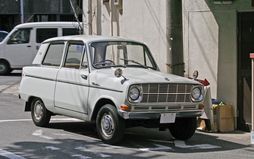
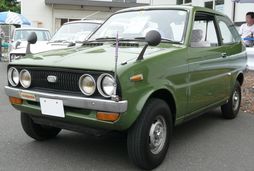
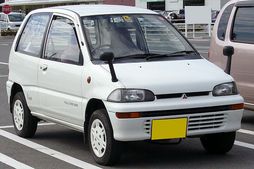
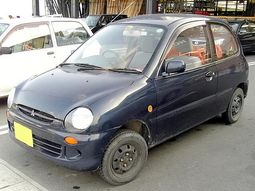
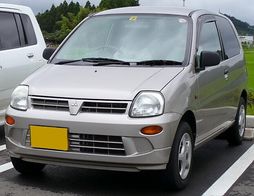
|